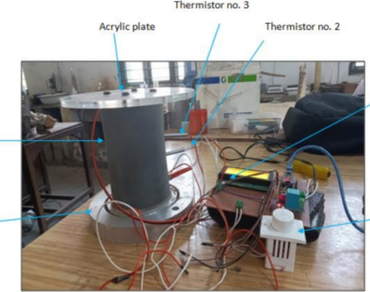Influence of microorganisms on thermal conductivity of soils and its potential impact on soil aggregation
*Article not assigned to an issue yet
Shah Manish V., Tandel Payal, Patel Avadhi, Chavda Ajay, Singh Shalini, Panchal Rakesh K., Upadhye Vijay, Singh Varsha K., Sinha Rajeshwar P., Sinha Rajeshwar P.
Research Articles | Published: 27 November, 2024
First Page: 0
Last Page: 0
Views: 2414
Keywords: Aggregation, Colonies, Curing period, Microbes, SEM, Thermal conductivity
Abstract
The significance of soil thermal conductivity in designing energy geo structures lies in its role in determining the heat transfer rate through materials. This study delves into the impact of bacterial presence on soil thermal conductivity, utilizing soil samples from six distinct regions in Gujarat—Surat, Madhavpur, Bhadbhut, Navsari, Dholera, and Bhuj. Employing a laboratory-scale experimental setup based on guarded hot plate method, thermal conductivity of soil samples was measured. Microorganisms were isolated from the soil samples using serial dilution and spread plate method, with two types of microorganisms selected from each soil sample. Measurements were conducted at curing periods of 7, 14, and 28 days, and comparative analysis of thermal conductivity values before and after treatment were performed. The findings revealed that E. coli led to reduction in thermal conductivity values in sandy soil, while S. aureus exhibited favorable outcomes in sandy soil compared to clayey soil. The study reveals significance of natural microbes present in raw soil and its potential use to enhance thermal conductivity of soils.

References
ASTM C177–13, Standard test method for steady-state heat flux measurements and thermal transmission properties by means of the guarded-hot-plate apparatus.
Basak S, Shetty PH (2021) Conventional microbial counting and identification techniques. In: Khan MS, Rahman MS (eds) Techniques to measure food safety and quality: microbial, chemical, and sensory. Springer International Publishing, Cham, pp 69–89
Borowik A, Wyszkowska J (2016) Impact of temperature on the biological properties of soil. Int Agrophys 30:1
Chen SX, Benet-Martínez V, Harris Bond M (2008) Bicultural Identity, bilingualism, and psychological adjustment in multicultural societies: immigration-based and globalization-based acculturation. J Persn 76(4):803–838
Cote AP, Benin AI, Ockwig NW, O’Keeffe M, Matzger AJ, Yaghi OM (2005) Porous, crystalline, covalent organic frameworks. Science 310(5751):1166–1170
Haigh SK (2012) Thermal conductivity of sands. Geotechnique 62(7):617–625
Likos WJ, Jaafar R (2013) Pore-scale model for water retention and fluid partitioning of partially saturated granular soil. J Geotech Geoenviron Eng 139(5):724–737
Lu S, Ren T, Gong Y, Horton R (2007) An improved model for predicting soil thermal conductivity from water content at room temperature. Soil Sci Soc Am J 71(1):8–14
Martinez BC, DeJong JT, Ginn TR, Montoya BM, Barkouki TH, Hunt C, Major D (2013) Experimental optimization of microbial-induced carbonate precipitation for soil improvement. J Geotech Geoenviron Eng 139(4):587–598
Naveed M, Duan J, Uddin S, Suleman M, Hui Y, Li H (2020) Application of microbially induced calcium carbonate precipitation with urea hydrolysis to improve the mechanical properties of soil. Ecol Eng 153:105885
Ochsner TE, Horton R, Ren T (2001) A new perspective on soil thermal properties. Soil Sci Soc Am J 65:1641–1647
Paassen LA, Ghose R, van der Linden TJ, van der Star WR, van Loosdrecht MC (2010) Quantifying biomediated ground improvement by ureolysis: large-scale biogrout experiment. J Geotech Geoenviron Engineer 136(12):1721–1728
Pawar SP, Nipate KV, Nemade PD (2015) Assessments of soil properties by using bacterial culture. Int J Innov Eng Res Technol 2(6):1–7
Xamán J, Lira L, Arce J (2009) Analysis of the temperature distribution in a guarded hot plate apparatus for measuring thermal conductivity. Appl Therml Eng 29:617–623
Author Information
Department of Applied Mechanics, L.D. College of Engineering, Ahmedabad, India